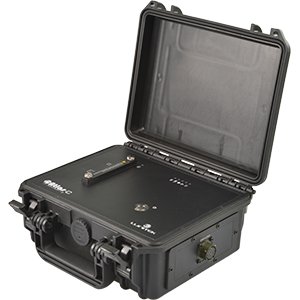


Atlas-C is a recorder for seismic signals.
It is available with 3, 6 or 9 synchronous channels for external inputs
(accelerometers or velocimeters).
Atlas-C was designed to be used in the field in tough conditions without any
additional protection.
An easy to access slot on the lid get the access to the additional removable microSD
card and to the HSPA modem sim card.
WiFi, GNSS and HSPA antennas are built-in within the housing; should there be
inadequate sky-view an external GNSS antenna connection is available with an
auto-switch function.
Atlas-C features a high capacity battery pack for your daily surveys or as a back-up
in case of power cuts.
Atlas-C is ready for use, no need to plug in antennas, no need for external battery
back-up, no need for an external 3G modem, it is all built-in.

Atlas-C is an easy to use instrument that simplifies your work in the field.
Everything you need is built-in inside the housing: batteries, GNSS antenna, WiFi,
HSPA.
If the Atlas-C has a good sky-view, the internal GNSS antenna functions perfectly;
vice-versa, when it is necessary to plug the external GNSS antenna in, the system
will auto-switch to the external one.
Data is simultaneously stored on the internal memory and on the external card.
You can eject the external card with your data and insert a empty one, without
worrying about downloading.
Just bring the Atlas-C and your sensor, it’s everything you’ll need for your seismic
surveys.

The Atlas-C power supply input can be directly connected to a small photovoltaic panel. The overall power consumption of the station is maximum 12W when internal batteries are completly discharged. The typical power consumption when the batteries are fully charged drops below 2W.

Atlas-C can be used with an accelerometric or a velocimetric sensor.
Atlas-C can be configured in-situ using WIFI or LAN cable.
If Atlas-C is used for permanent monitoring, it can be reached remotely using the
built-in HSPA modem or using LAN connection in order to link it, for example, to an
ADSL modem.
ATLAS-C models available
| Inputs | Differential |
| Channels | low noise 24bit |
| Dynamic Range | >136dB@100 Sps |
| Sampling Rate | 10,100,200,250,500,1000 Sps |
| Sampling Topology | Synchronous |
| Data Format | MiniSeed or Proprietary |
| Trigger | STA/LTA |
| Timing | Built-in GNSS receiver |
| Timestamp | Encapsulated in data |
| LAN | 10/100 ethernet port |
| WiFi | Optional built-in |
| Cellular Modem | Optional built-in |
| Power Supply | 9-28 Volt DC – power consumption < 2W |
| Back up Battery | Internal LiPo |
| System Autonomy w/o external supply | 33 hours |
| Configuration | Web Interface |
| Compatibility | Earthworm,Antelope,Geopsy,SeiscomP and SeisGram2K |
| Weight | 2Kg |
| IP protection | IP68 |
| Temperature Range | -40°C to +70°C |
* LiPo batteries can be discharged between -20°C to +70°C.
LiPo batteries can be charged between 0°C to +45C°.
If temperature exceeds these limits, the charging process is suspended.
Answer: Yes, ATLAS may do both tasks in parallel. For event-triggering, threshold exceedance instead of STA/LTA is recommended for accelerometers.
Answer: The telemetry works through SeedLINK protocol, which holds data in its ring buffer whose size is by default 1GB (expandable): it corresponds to some days of continuous recording. When the telemetry goes down, the client may request data from the last packet received before the break and then recovered all the missing data. This is automatically handled by the SeedLINK client. Whether the telemetry is up or down, the device always stores data in a separate folder and the telemetry (SeedLINK) server detects it, and copies data in its ring buffer, ready to be sent on request.
Answer: This could be done in two ways. For example, if the 2 or more ATLAS digitizers are in the same LAN segment, either ATLAS could reach the trigger status and trigger all the other units with a broadcast message. If they are installed in different LAN segments (for example there is a gateway in the middle), this won't work and we should install an additional module on a Linux machine that catches the alarms from the devices and implements a trigger voting algorithm.
Answer: MiniSEED, just like the continuous recording. But if we install the QUAKELOGIC Event Watchdog software to the remote server, the trigger files may be sent automatically to a remote server and exported in ASCII format, or the server may extract the event data from the continuous recording and perform the export. For example, this would be the best way to interact with a LABVIEW application.
Answer: The ATLAS digitizer can communicate with the remote server (Linux Machine) through MQTT and SeedLINK. The Linux Machine takes care of storing all the continuous recordings from the ATLAS devices and receives the trigger data through MQTT or just extracts it from the continuous buffer. At this point, data is still available in MiniSEED. Once we have a time window for an event, we may export it in ASCII.
Answer: The ATLAS digitizer can be powered by a 12 V solar panel (>100 W). The system requires a solar panel, 12V backup battery and controller unit. QuakeLogic can provide all these auxiliary hardware including on-site installation.
